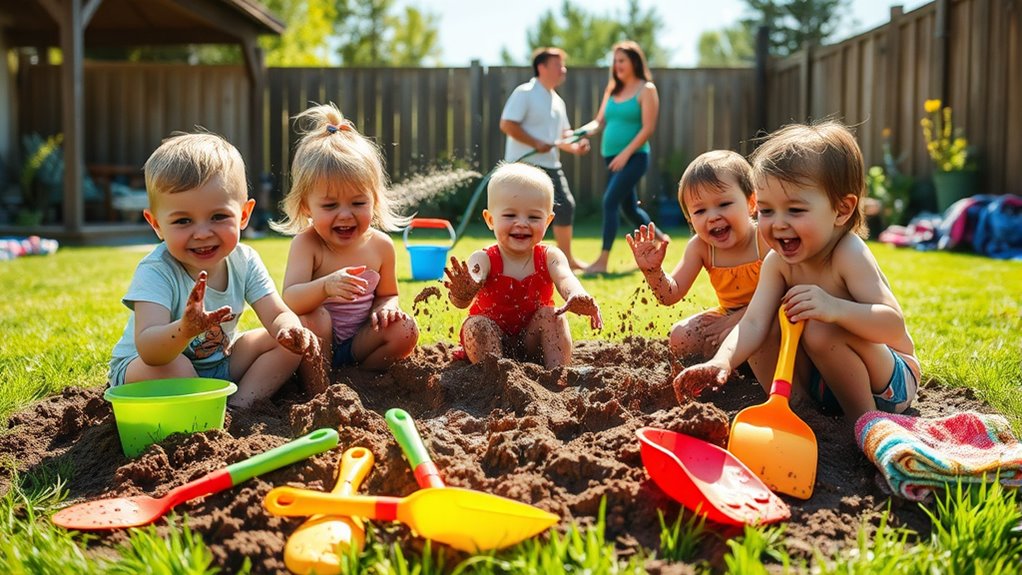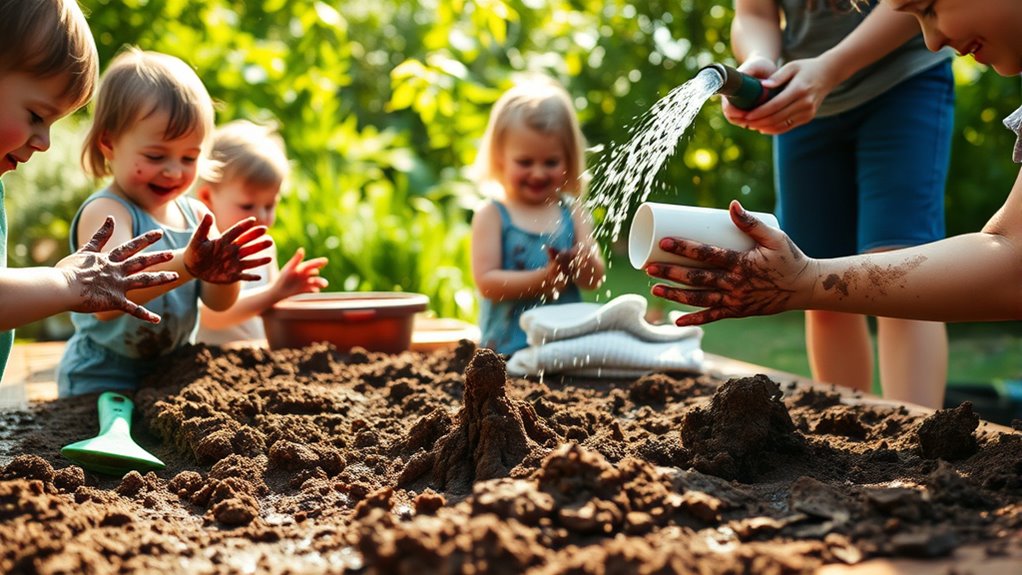To enjoy mud play without the mess, start by setting up a designated area with a tarp or plastic sheeting underneath. Dress kids in waterproof gear—jackets, pants, gloves, and sturdy boots—and keep tools nearby. Use outdoor rinsing with a hose to wash off gear right away, and encourage hand and foot cleaning after play. Dedicate a space for muddy clothes and keep everything organized to make cleanup quick and simple. There’s more to explore for fuss-free fun!
Key Takeaways
- Designate a specific mud play area with a tarp and containment tools to control mess and facilitate cleanup.
- Equip children with waterproof clothing and sturdy boots to stay dry and reduce mud tracking.
- Keep cleaning supplies like hoses and soapy water nearby for quick rinsing of gear and shoes after play.
- Encourage immediate hand and foot washing post-play to prevent mud from spreading indoors.
- Store muddy gear separately and dry outdoor clothing in the sun to streamline cleanup and reduce indoor clutter.

Mud play can be messy, but it doesn’t have to be chaotic. With a little planning and the right equipment, you can enjoy the fun without the headache of a huge cleanup afterward. The key is to set up an organized space that contains the mess and makes cleanup easier, starting with the gear your kids wear. Invest in water resistant gear like waterproof jackets, pants, and gloves. These keep mud and water from seeping through, making it easier for you to clean up and preventing your kids from getting soaked and cold. Outdoor footwear is equally important; sturdy, waterproof boots or shoes designed for rough outdoor conditions will not only keep their feet dry but also prevent mud from deep-staining their regular shoes. When kids are dressed in appropriate gear, they can plunge into mud play freely without constantly worrying about their clothes or shoes getting ruined.
Next, you’ll want to choose a designated area for the mud play. If you have a backyard, set up a specific zone with a tarp or plastic sheeting underneath to catch excess mud and water. This makes it easier to contain the mess and prevents mud from spreading to other parts of your yard or house. You can also use a small, portable sandbox or a plastic kiddie pool filled with mud, which allows for controlled, contained play. Keep a few tools nearby—spades, buckets, and molds—so kids can be creative without running all over the yard, which helps contain the chaos. Having a clear boundary also helps kids understand where they’re allowed to play, minimizing the spread of mud into your home. Additionally, choosing the right projector type can help you monitor outdoor activities effectively, especially in bright environments.
When it comes to cleanup, having a plan in place makes a big difference. Keep a hose or a bucket of soapy water close by to rinse off muddy gear and shoes right after playtime. Encourage kids to wash their hands and feet immediately after finishing to prevent mud from tracking inside. Once play is over, gather all gear, and rinse mud off outdoors whenever possible. For clothing and gear that can’t be washed immediately, let them dry outside in the sun if weather permits, which helps eliminate residual mud and odors faster. Having dedicated space in your laundry area for muddy clothes simplifies the process—just toss everything in without worry. Remember, the goal is to make cleanup quick and straightforward, so you can focus on the fun rather than the fuss. By preparing with water resistant gear, outdoor footwear, and a designated play zone, you’ll keep mud play safe, enjoyable, and surprisingly manageable.
Frequently Asked Questions
How Can I Prevent Mud From Staining Clothes?
To prevent mud from staining clothes, wear stain-resistant fabrics like nylon or polyester, which repel mud better. You can also apply a fabric protector spray beforehand for added protection. During play, have your kids wear old, easy-to-clean clothes and keep a wet cloth handy for quick mud removal. Afterward, treat muddy clothing promptly with stain removers and wash in cold water to keep stains from setting.
What Are the Best Materials for a Safe Mud Play Area?
Imagine creating a safe haven where mud safety reigns supreme. Opt for non-toxic, smooth-textured materials like organic soil, play sand, or natural clay, which mimic sandbox alternatives without harmful chemicals. These materials provide a gentle, stable surface that minimizes injuries and keeps mud manageable. By choosing the right textures, you turn chaos into calm, ensuring your kids enjoy mud play safely without the mess spiraling out of control.
How Long Does It Typically Take to Clean up After Mud Play?
Cleaning up after mud play usually takes about 15 to 30 minutes, depending on how muddy your kids got. You’ll want to start by rinsing off muddy footprints with a hose or wet cloth. Use effective drying techniques like towel drying or air drying to speed up the process. Be patient and thorough, making sure all muddy spots are cleaned to prevent stains and keep the area safe and tidy.
Are There Allergy Concerns Related to Mud Play?
You should be aware that mud play can trigger allergy concerns, especially if you or your child have known allergy triggers or skin sensitivities. Mud may contain pollen, mold, or other irritants that can cause allergic reactions. To minimize risks, check the mud’s ingredients or source, and monitor for any skin sensitivities or allergic responses during and after play. Always have allergy remedies handy just in case.
Can Mud Play Be Adapted for Indoor Environments?
Yes, you can adapt mud play for indoor environments by creating an indoor mud simulation. Use a large, washable container filled with safe, non-toxic materials like clay or oatmeal to mimic mud. You’ll want to lay down a waterproof mat or tarp to protect floors and make cleanup easier. This way, you provide a fun, sensory experience without the mess, keeping the environment safe and enjoyable for everyone involved.
Conclusion
By following these simple setup and cleanup tips, you can enjoy mud play without the chaos. Imagine setting up a designated muddy zone with tarps and having your kids wear waterproof gear—mess remains manageable, and everyone has fun. For example, Sarah’s backyard transformed into a muddy adventure land, thanks to a quick cleanup routine she established. With a little planning, you’ll create joyful mud play moments that are easy to contain and clean up afterward.









